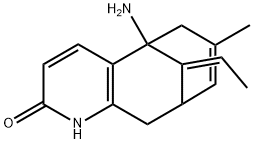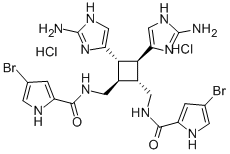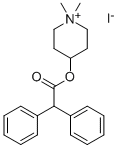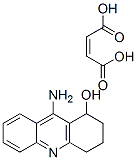1-(4-METHOXYBENZYL)-4-OXO-1,4-DIHYDRO-3-QUINOLINECARBOXYLIC ACID
Synonym(s):1-(4-methoxybenzyl)-4-oxo-1,4-dihydroquinoline-3-carboxylic acid;Benzyl quinolone carboxylic acid
- CAS NO.:338747-41-4
- Empirical Formula: C18H15NO4
- Molecular Weight: 309.32
- MDL number: MFCD01315710
- SAFETY DATA SHEET (SDS)
- Update Date: 2024-11-19 20:33:22

What is 1-(4-METHOXYBENZYL)-4-OXO-1,4-DIHYDRO-3-QUINOLINECARBOXYLIC ACID?
Description
BQCA is a highly selective positive allosteric modulator of the M1 muscarinic acetylcholine receptor (mAChR), as it dose-
The Uses of 1-(4-METHOXYBENZYL)-4-OXO-1,4-DIHYDRO-3-QUINOLINECARBOXYLIC ACID
BQCA is a highly selective positive allosteric modulator of the M1 muscarinic acetylcholine receptor (mAChR).
What are the applications of Application
BQCA is a highly selective allosteric potentiator of the M1 muscarinic acetylcholine receptor (mAChR)
Biochem/physiol Actions
BQCA is a potent muscarinic M1 receptor positive allosteric modulator with selectivity for M1 over M2-M5. It potentiates M1 activity in in vitro and in vivo assays and is orally bioavailable. Muscarinic 1 (M1) receptors are expressed in brain regions responsible for attention and memory, including hippocampus, cortex, and striatum. BQCA binds allosterically to M1 to enhance the binding and efficacy of ACh at the receptor. M1 activation is a proposed mechanism for increasing information processing in disease states, such as Alzheimer′s. M1 agonists are being studied as potential therapeutic agents to treat Alzheimer′s disease and the cognitive and negative symptoms of schizophrenia. BQCA has been shown to improve performance in cognition tasks and increase cerebral blood flow.
in vitro
bqca alone showed no effect on calcium mobilization up to 10 μm but increased ach potency 128.8 ± 20.1-fold at 100 μm. in cho cells stably expressing human m1, bqca (100 μm) activated m1 in the absence of ach to an approximate 50% maximal response. bqca had no effect on m2–m5, indicating 100-fold selectivity [1]. bqca dose-dependently reduced the concentration of acetylcholine required to activate the m1 receptor [1]. the effective range for potentiation of m1 in cells by bqca was 0.1 to 100 μm, with an inflection point value of 845 nm when 3 nm acetylcholine was used [1].
in vivo
in wild-type mice, bqca (15 mg/kg) induced c-fos and arc rna in the cortex, hippocampus, and cerebellum and the arc was also elevated in the striatum. bqca had no effect in m1-/- mice. in wild-type mice, oral administration of 15 mg/kg bqca increased the ratio of phosphoerk (perk) to total erk by 28%. bqca showed excellent brain penetration and increased the firing rate of medial prefrontal cortex neurons in vivo in rats [2].
storage
Store at -20°C
References
[1] ma l, seager m a, wittmann m, et al. selective activation of the m1 muscarinic acetylcholine receptor achieved by allosteric potentiation[j]. proceedings of the national academy of sciences, 2009, 106(37): 15950-15955.
[2] shirey j k, brady a e, jones p j, et al. a selective allosteric potentiator of the m1 muscarinic acetylcholine receptor increases activity of medial prefrontal cortical neurons and restores impairments in reversal learning[j]. journal of neuroscience, 2009, 29(45): 14271-14286.
Properties of 1-(4-METHOXYBENZYL)-4-OXO-1,4-DIHYDRO-3-QUINOLINECARBOXYLIC ACID
| Melting point: | 210-212 °C |
| Boiling point: | 492.6±45.0 °C(Predicted) |
| Density | 1.346±0.06 g/cm3(Predicted) |
| storage temp. | 2-8°C |
| solubility | DMSO: soluble10mg/mL (clear solution) |
| form | powder |
| pka | 0.70±0.20(Predicted) |
| color | white to beige |
Safety information for 1-(4-METHOXYBENZYL)-4-OXO-1,4-DIHYDRO-3-QUINOLINECARBOXYLIC ACID
| Signal word | Warning |
| Pictogram(s) |
 Exclamation Mark Irritant GHS07 |
| GHS Hazard Statements |
H302:Acute toxicity,oral |
| Precautionary Statement Codes |
P280:Wear protective gloves/protective clothing/eye protection/face protection. P305+P351+P338:IF IN EYES: Rinse cautiously with water for several minutes. Remove contact lenses, if present and easy to do. Continuerinsing. |
Computed Descriptors for 1-(4-METHOXYBENZYL)-4-OXO-1,4-DIHYDRO-3-QUINOLINECARBOXYLIC ACID
New Products
4-Fluorophenylacetic acid 4-Methylphenylacetic acid N-Boc-D-alaninol N-BOC-D/L-ALANINOL Tert-butyl bis(2-chloroethyl)carbamate 3-Morpholino-1-(4-nitrophenyl)-5,6-dihydropyridin- 2(1H)-one Furan-2,5-Dicarboxylic Acid Tropic acid S-2-CHLORO PROPIONIC ACID ETHYL ISOCYANOACETATE 2-Bromo-1,3-Bis(Dimethylamino)Trimethinium Hexafluorophosphate (6-METHYL-[1,3]DITHIOLO[4,5-b]QUINOXALIN-2-ONE INDAZOLE-3-CARBOXYLIC ACID 4-IODO BENZOIC ACID (2-Hydroxyphenyl)acetonitrile 4-Bromopyrazole 5,6-Dimethoxyindanone 2-(Cyanocyclohexyl)acetic acid 4-methoxy-3,5-dinitropyridine 2-aminopropyl benzoate hydrochloride 1-(4-(aminomethyl)benzyl)urea hydrochloride diethyl 2-(2-((tertbutoxycarbonyl)amino) ethyl)malonate tert-butyl 4- (ureidomethyl)benzylcarbamate Ethyl-2-chloro((4-methoxyphenyl)hydrazono)acetateRelated products of tetrahydrofuran


![6-[5-[(2S)-2-AZETIDINYLMETHOXY]-3-PYRIDINYL]-5-HEXYN-1-OL DIHYDROCHLORIDE](https://img.chemicalbook.in/CAS/GIF/820231-95-6.gif)

![4-(N-[3-CHLOROPHENYL]-CARBAMOYLOXY)-2-BUTYNYLTRIMETHYLAMMONIUM CHLORIDE](https://img.chemicalbook.in/CAS/GIF/55-45-8.gif)



You may like
-
 BQCA CAS 338747-41-4View Details
BQCA CAS 338747-41-4View Details
338747-41-4 -
 2033-24-1 98%View Details
2033-24-1 98%View Details
2033-24-1 -
 1975-50-4 98%View Details
1975-50-4 98%View Details
1975-50-4 -
 2-HYDROXY BENZYL ALCOHOL 98%View Details
2-HYDROXY BENZYL ALCOHOL 98%View Details
90-01-7 -
 2-Chloro-1,3-Bis(Dimethylamino)Trimethinium Hexafluorophosphate 221615-75-4 98%View Details
2-Chloro-1,3-Bis(Dimethylamino)Trimethinium Hexafluorophosphate 221615-75-4 98%View Details
221615-75-4 -
 61397-56-6 CIS BROMO BENZOATE 98%View Details
61397-56-6 CIS BROMO BENZOATE 98%View Details
61397-56-6 -
 14714-50-2 (2-Hydroxyphenyl)acetonitrile 98+View Details
14714-50-2 (2-Hydroxyphenyl)acetonitrile 98+View Details
14714-50-2 -
 118753-70-1 98+View Details
118753-70-1 98+View Details
118753-70-1